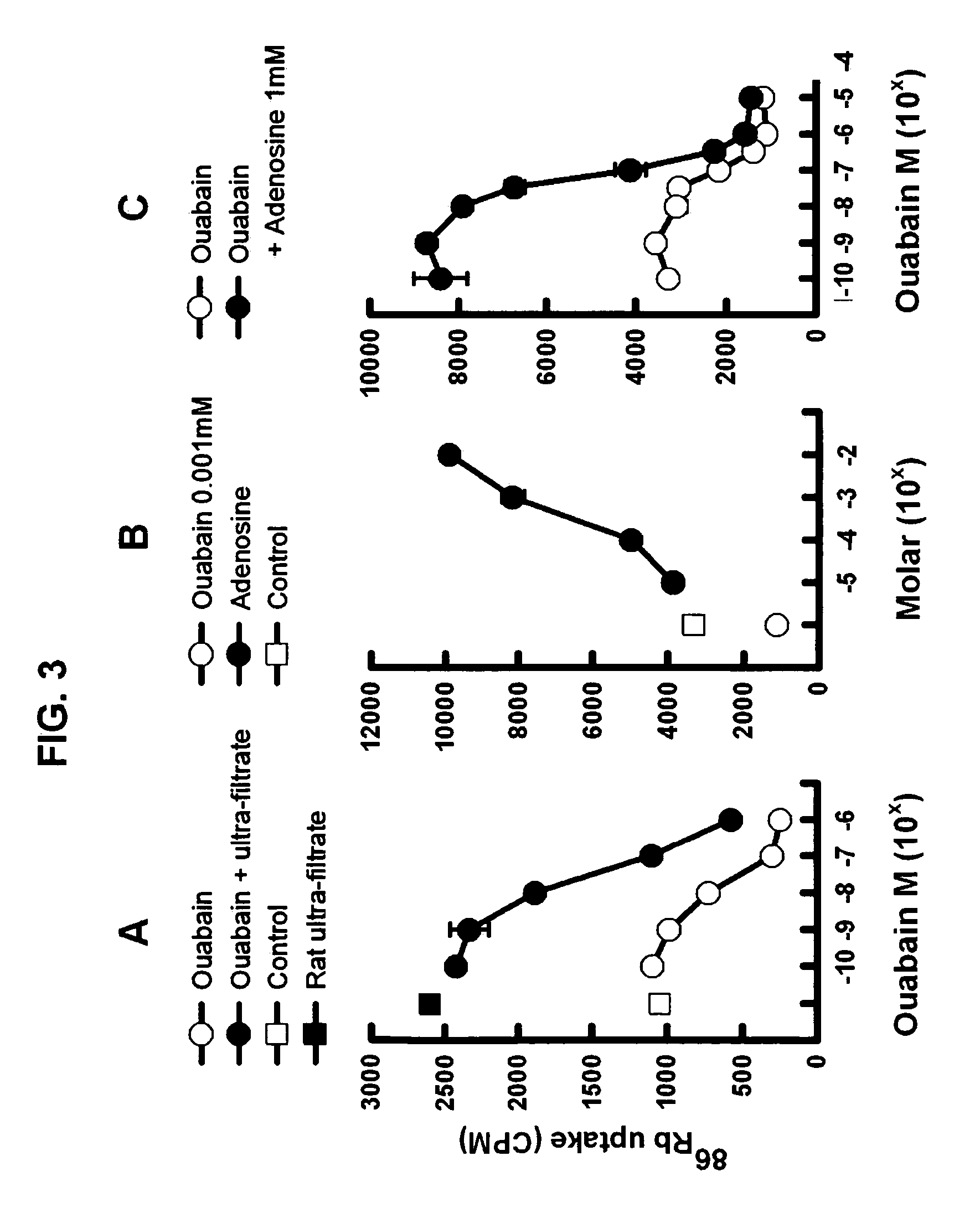Use of purine nucleosides to stimulate Na/K ATPase and to treat or prevent shock
a technology of purine nucleosides and na/k atpase, which is applied in the direction of biocide, animal husbandry, carbohydrate active ingredients, etc., can solve the problems of hemorrhagic shock, a life-threatening condition, and a complex process of hemorrhagic shock, so as to increase the activity of na/k atpas
- Summary
- Abstract
- Description
- Claims
- Application Information
AI Technical Summary
Benefits of technology
Problems solved by technology
Method used
Image
Examples
example 1a
Na / K ATPase Assay
[0136] Human red blood cells of any group-type were donated for research by the Blood Bank of the University Of Maryland, School of Medicine. Five ml of red cells are washed 3 times in 40 ml of Potassium free Ringers solution (141 mM NaCl, 1 mM H2NaPO4, 0.5 mM CaCl2, 1 mM MgSO4, 4.5 mM glucose, 10 mM HEPES pH7.4). 50 μl of washed red cells are added to 220 μl of potassium free Ringers solution. 30, 10, 3 or 1 μl of ultra-filtrate, HPLC (high performance liquid chromatography) fraction, or adenosine, inosine, guanosine, deoxyadenosine, deoxyguanosine, caffeine, aminophylline, dipyridamole, NBTI, 6thioinosine, 6thioguanosine, or EHNA (all in buffer) is added to the mixture and incubated for 20 min. 4 μCi of 86RbCl is added and incubated for 4 hrs at 37° C. The mixture is than washed three times with 4° C. Potassium free Ringers solution and the cells counted in a gamma counter (Packard, Cobra II). Na / K ATPase activity is expressed as the CPM (counts per minute) (CPM / ...
example 1b
Ultra-Filtrate from Plasma and Serum
[0137] Whole blood is collected from cannulated femoral arteries of pentobarbital anesthetized dogs, or from unanesthetized rats that have indwelling cannulas in the femoral artery. The whole blood is centrifuged at 3000 rpm at 4° C. for 20 minutes to remove the cellular component. Alternatively, fetal calf serum is used. The plasma or serum is placed in Centriprep™ 30 (Millipore Corp. MA) and centrifuged at 200 rpm at 4° C. 2 hrs to remove proteins over 30K MW (molecular weight). This filtrate is then placed over Sep-Pac C18™ cartridges (Waters Corp, MA), and the flow-through collected and called ultra-filtrate.
example 1c
Purification of Ultra-Filtrate by HPLC
[0138] Further fractionation was performed using sequential chromatography that included size exclusion (SHODEX™, Phenomenex, CA), amine (Phenomenex, CA) and hydrophilic interaction (PolyLC, MD) chromatography on HPLC, assaying each fraction for Na / K ATPase activity. The active fraction was isolated and identified by UV absorption as adenosine or one of its analogs (FIG. 1). Adenosine purchased from SigmaAldrich was shown to stimulate Na / K ATPase in a dose-dependent manner and to have the same retention time as the active fraction on all three HPLC columns.
PUM
| Property | Measurement | Unit |
|---|---|---|
| pressure | aaaaa | aaaaa |
| volume | aaaaa | aaaaa |
| time | aaaaa | aaaaa |
Abstract
Description
Claims
Application Information
 Login to View More
Login to View More - R&D
- Intellectual Property
- Life Sciences
- Materials
- Tech Scout
- Unparalleled Data Quality
- Higher Quality Content
- 60% Fewer Hallucinations
Browse by: Latest US Patents, China's latest patents, Technical Efficacy Thesaurus, Application Domain, Technology Topic, Popular Technical Reports.
© 2025 PatSnap. All rights reserved.Legal|Privacy policy|Modern Slavery Act Transparency Statement|Sitemap|About US| Contact US: help@patsnap.com



